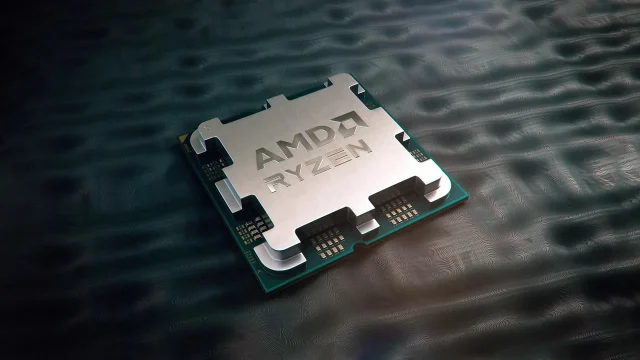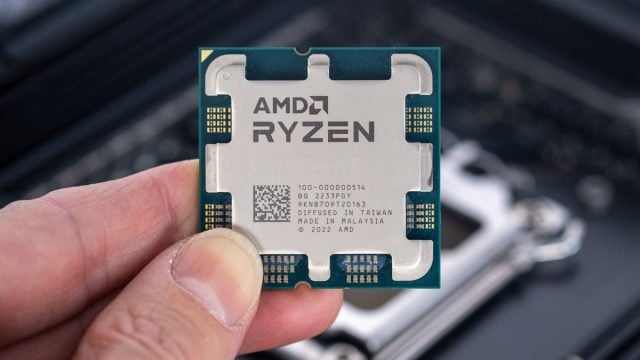Zen 5 Architecture: Everything Known About AMD Ryzen 9000 Series

AMD had introduced many innovations by launching the Zen 4 architecture in 2022. With this architecture, DDR5 memories were used, and DDR4 support was discontinued. While the transition to the AM5 socket type was made, new motherboards were launched. Now a new architecture, a new generation of CPUs are coming: Zen 5 architecture and Ryzen 9000 “Granite Ridge” series.
Leaks that have been circulating for a while show that there may be big leaps in performance. Normally we don’t have all the details about the new series, but our rumors are very promising. Without further ado, let’s compile and summarize what is known about the new Ryzen chips.
Ryzen 9000 Series Release Date
In January 2024, AMD confirmed that Zen 5 architecture processors would be released in the second quarter of the year. If we remember that Zen 4 was released in September 2022, we can expect Zen 5 desktop processors to be released in the same time period. Let us even state that we expect an announcement at Computex to be held in the summer.
In recent days, motherboard manufacturers have started to offer support for Zen 5 CPUs one by one. If companies start to offer this support, the new series should not be far away.
gigabyte
Gigabyte announced that X670, B650 and A620 motherboards are compatible with Ryzen 9000 CPUs. The motherboard partner has officially released AGESA 1.1.7.0 beta BIOS updates supporting the new Zen 5 chips for all its 600 series motherboards and confirmed the Ryzen 9000 name that AMD has chosen for the new chip series.
AMD is making Ryzen 9000 backwards compatible with first-generation AM5 motherboards (similar to AM4), allowing Ryzen 7000/8000 owners to upgrade to the Ryzen 9000 series without purchasing a new motherboard. We hope this support will continue for many years.
ASUS
ASUS has become another motherboard manufacturer adding upcoming Zen 5 support for its ROG and ROG Strix X670E motherboards. The new Beta BIOS updates also include the AGESA 1.1.7.0 update. Additionally, AMD changed the AGESA naming scheme from ComboAM5PI to FireRangePi.
MSI
AGESA ComboFi 1.1.7.0 is an update to the next generation AMD Ryzen processors, officially known as the Ryzen 9000 series. MSI is another motherboard manufacturer that has started adding support for Zen 5 chips.

Strix Point Mobile and Granite Ridge Desktop
The new Zen 5 architecture will be used in desktop processors codenamed Granite Ridge and mobile processors codenamed Strix Point. It will also come to the Threadripper platform for the EPYC and HEDT platform used on servers. However, we do not know which series will be released first.
Expected features
No sharing has been made by AMD, but leak sources continue to provide various information as always. Reported leaks indicate that the 16-core maximum configuration will continue as is in Zen 4 chips.
As with every generation, we will see some improvements in clock speed with the Ryzen 9000 series. However, we do not expect huge increases in frequencies. New cores and frequencies aside, the red team will rely on architectural improvements to increase performance. According to the information received, a significant part of the performance increase will occur thanks to architectural improvements.
Strong rumors in January 2024 indicate that Zen 5 will come with IPC improvements of up to 30%. If this is true it’s really exciting. Even if it is not 30% but close to it, we can say that the new generation processors will be seriously powerful. If the rumors are true, it will be the biggest cross-generation IPC increase since the original Zen generation debuted in 2017. As a side note, the rumors may be a bit exaggerated. The 30% increase represents the maximum value and naturally, not all processor models will see the same increase.
Moving on to the memory side, we expect AMD to improve native memory support. Probably direct DDR5-6400 memory compatibility will be provided with the Ryzen 9000 series. On the other hand, higher speed memories can also be used with EXPO profiles and overclocking.
Other rumors indicate that the Granite Ridge family will come with support for FP16 AVX512 commands. Also the CPU cache, including L1, L2 and L3, can increase significantly.

There is a high probability that Zen 5 will be produced with the TSMC 3nm manufacturing process. Although the cores are based on 3nm technologies, the I/O die may be produced with an older technology, as in Zen 4. According to expectations, TSMC’s 4nm and 3nm process technologies will be used together. These process technologies are better than the previous 5nm process used in the Zen 4 architecture.
As a reminder, Zen 5 architecture will be used in desktop/mobile Ryzen and EPYC processors for servers. Some of these CPUs will be manufactured with TSMC’s 3nm-class manufacturing process, while others will be based on 4nm-class manufacturing technology. Zen 5-based processors will significantly increase performance in both single-threaded and multi-threaded workloads It is predicted.
AMD said that the new CPUs will have an improved version of artificial intelligence accelerators. Thus, upcoming Ryzen chips will become much more capable of handling AI-focused tasks natively.
RDNA 3.5 Graphics Architecture
AMD confirmed firsthand that Zen 5 processors will have the new RDNA 3.5 graphics architecture. If you remember, Ryzen 7000 processors came with integrated graphics units. With the RDNA 3.5 architecture, the capabilities of internal graphics will improve a little more. It’s not likely to be a major upgrade, but we can say that the iGPU performance will be better compared to the Ryzen 7000 series.
Artificial Intelligence: XDNA 2 Architecture
Information is limited, but we expect significant improvements in AI performance and iGPU performance thanks to XDNA 2 and RDNA 3.5. XDNA 2 is expected to deliver over 70 TOPS in AI performance, which is almost double the 40 TOPS set for “next generation AI computers”.
Ryzen 9000 Processors
momomo_us And @harukaze5719 Various reports by have revealed a slew of new Zen 5 CPUs, including desktop and mobile variants. AMD is introducing new 170W Zen 5 Granite Ridge CPUs, 128W Zen 5-based Strix Point APUs (likely to be called Strix Point Halo) and Fire Range with 16 Zen 5 cores and up to 55W TDP reveals that he is working on a mysterious new mobile series codenamed.
Starting with APUs, there are five SKUs in total: three Strix Point and two Fire Range models. Strix Point chips include Ryzen 7 and Ryzen 9 models with 128W TDP in the B0 phase, meaning these are desktop chips. Fire Range chips consist of 8-core and 16-core SKUs, again at the B0 stage but with a much lower 55W TDP.
There are several Granite Ridge models in the shipping manifest, one of which has six cores and a 105W TDP at A0 stage. A dual octa-core 170W chip (B0) is also listed, but a codename is not given. It is estimated that these are Granite Ridge desktop chips.
Strix Point will be the code name of the next generation Zen 5 mobile CPUs, which are aimed to replace the AMD Ryzen 8040 series. Strix Point is claimed to feature up to twelve cores, featuring a mix of Zen 5 and Zen 5c cores. However, it will feature AMD’s XDNA 2 neural processing unit (NPU) and an upgraded graphics engine with an improved RDNA 3 architecture, currently called “RDNA 3.5”.
Strix Point Halo
The interesting thing is that Strix Point APUs have a TDP of 128W, which we can call extremely high. This TDP value is much higher than AMD’s NPU-enabled Ryzen mobile CPUs, including the Ryzen 7040 series and Ryzen 8040 series. The 128W chips may come codenamed Strix Point Halo, which is an extension of Strix Point with a chiplet-based design and a much more powerful integrated GPU.
fire range
The most mysterious models on the shipping list are codenamed Fire Range. We haven’t heard of this codename before, but these chips are powered by 16-core Ryzen in a chiplet-style architecture. Dragon Range, consisting of 9 79xxHX series mobile CPUs, is expected to be the Zen 5 version. We can’t be sure of the details, but it’s no surprise that AMD wants to deliver 16 Zen 5 cores to mobile devices, just like it did with Zen 4.
Zen 5 Performance
Until we see performance figures from AMD or independent testing, performance is pure speculation. However, let’s reconsider the rumors. If changes are made as said, the changes in the IPC maximum 30% The increase claim may be true.
If serious architectural improvements, a new cache design, higher cache amounts, increased frequencies and new kernel design are made, everything is fine kün. So Zen 5 chips may come with impressive performance gains. Considering Intel’s ambitious future in new generations, AMD may also want to keep its guard up.

Zen 5 Granite Ridge is being prepared as a response to the processor series codenamed Intel Arrow Lake. It looks like the second half of 2024 will host a really important competition in the CPU arena.
Continue with AM5 Socket
The red team promised that the AM5 socket, which came into our lives with the Ryzen 7000 series, would be long-lasting like AM4. If you have recently switched to a motherboard with AM5 socket or are thinking of switching, let us say that the Zen 5 processors on the horizon will be compatible with these motherboards. So you don’t need to upgrade your other computer parts.
New generation motherboards will probably be introduced with the Ryzen 9000 series. Older generation motherboards will be compatible with the Zen 5 family with the BIOS update.
Hybrid Architecture Adoptable: Zen 5 and Zen 5c
Performancedatabases.com recently published leaked CPU-Z and HWINFO screenshots of the AMD Zen 5 Strix Point APU, which is expected to have 4 performance and 8 efficiency cores. He meant it. Well what does it mean? If you remember, Intel had switched to a big.LITTLE-like hybrid architecture with P-Core (performance cores) and E-Core (efficiency cores) cores. Thus, a high number of cores can be offered with high efficiency.
There is a possibility that the new generation AMD APU series, based on the Zen 5 architecture, will have a hybrid design that combines the Zen5 and Zen5c cores. These rumors include mobile APUs codenamed Strix Point. Strix Point APU could be AMD’s first hybrid processor with ‘big’ and ‘small’ cores. On the other hand, both Zen 5 and Zen 5c cores are claimed to offer “multi-threading” support. In this way, Strix Point will be able to process 24 threads simultaneously.
We do not know whether the Big.LITTLE architecture will be used in the 9000 series desktop chips. However, AMD is already using this design in Ryzen 8500G and 8300G processors. Therefore, it would not be surprising to see it in both mobile and desktop Zen 5 chips.
Let’s go to a leak from the past. Unnamed Strix Point APU, four full-fledged Zen 5 cores with 16 MB L3 cache, eight Zen 5c cores with 8 MB L3 cache, and 8 based on RDNA 3.5 architecture With WGP (1024 stream processor) will pack an integrated GPU into a large monolithic die. It is said that the CPU cores will be distributed on two core complexes (CCX).
Linux Patches
AMD has released new Linux patches labeled “x86/urgent” for AMD Family 26 CPUs, also known as the Zen 5 CPU family. published. The chip manufacturer is thus preparing the ground for the arrival of Zen 5 in Linux.
There are currently a total of 64 potential Zen 5 CPU model numbers being built into the code to account for future development and releases. This is intended to provide broad support for testing with handheld APU designs, more powerful desktop integrated graphics, and the like. Other leaks include AMD’s Strix Point mobile CPU It points out that they have adopted Zen 5c cores.

